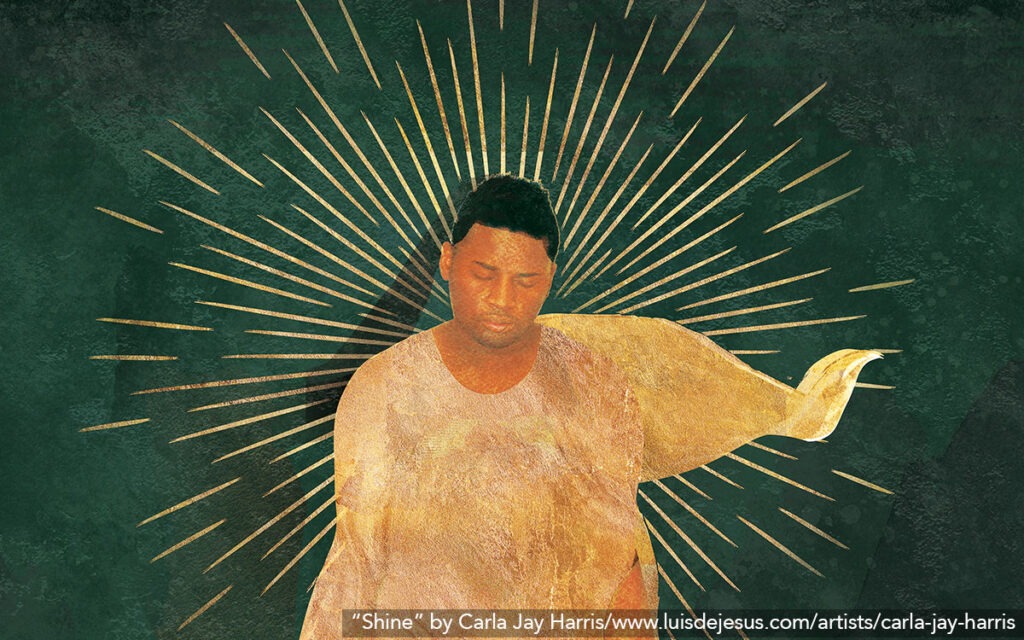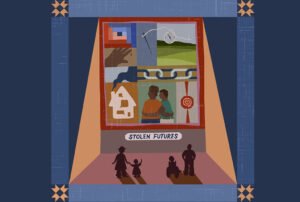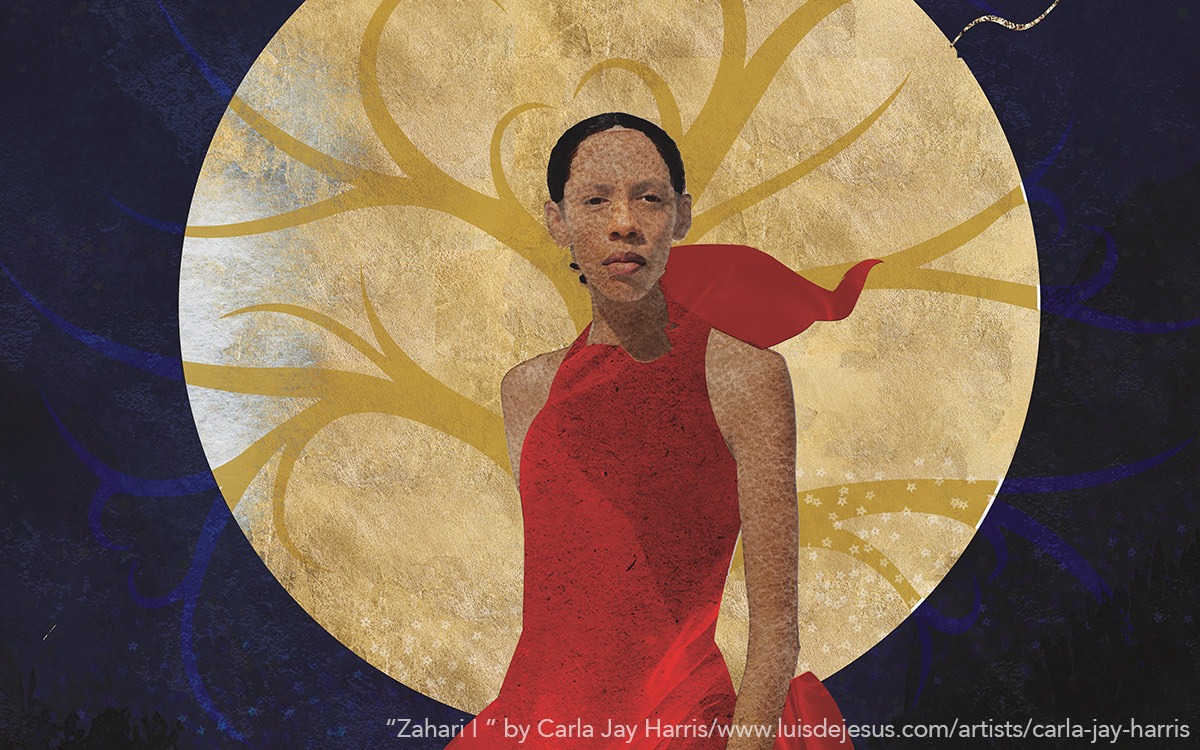
Editors’ note: This article is from NPQ’s spring 2023 issue, “The Space Beyond: Building the Way.”
Click here to download this article as it appears in the magazine, with accompanying artwork.
I. The Black Leader’s Burden
In the past three years, many of us who have been advancing justice initiatives have either questioned or outright criticized traditional top-down leadership as one root cause of the perpetuation of structural racism. The Aspen Institute’s definition of the term is instructive here. Structural racism “identifies dimensions of our history and culture that have allowed privileges associated with ‘whiteness’ and disadvantages associated with ‘color’ to endure and adapt over time.”1 The structure of labor is one such “dimension of our history.” Though it has looked different from one epoch to the next, throughout this country’s labor history—from chattel slavery to the industrial age to the information age—White men with institutional power and authority have effectively shaped systems both to protect and propel the interests of White people. Thus, those of us doing racial justice work have posed a question that is at the very least worth grappling with: Can we trust an organizational leadership paradigm forged over centuries of oppression to lead us toward liberation, or do we need to reconfigure that model in order to produce different outcomes? We have further asserted that because of the inequitable distribution of access and opportunity that stems from racial capitalism, our leadership teams may not reflect our most qualified or hardest working (the twin pillars of merit) but rather those who were set up and supported to succeed from the beginning (the sine qua non of privilege).
The critique has been valuable. It has challenged leaders to look within, ask themselves hard questions, and uncover hidden assumptions that may be implicitly guiding their choices and—perhaps—impeding the progress toward the more just organizations they claim they want to build.
The critique has also, admittedly, been weaponized—often, against leaders of color who are ascending into organizational leadership. Just as these folks are assuming the mantle, they are being met with direct assaults on the established structures and forms of power. In the past three years, I have worked with or spoken to several dozen of these leaders. Nearly all have faced power struggles from within that they didn’t anticipate and can’t seem to get beyond without considerable time and energy that would otherwise be spent on the job they believed they were hired to perform. In some instances, the challenge presents as a clarity gap— employees stating that they don’t understand how decisions are made or what their roles are. In other instances, it presents as an accountability and transparency gap—employees asking (in some cases, demanding) to have access to information that may or may not be relevant to their job. And in yet others, the gap employees believe the organization needs to close is one of proximity—those closest to the work or who share certain identities with those the mission seeks to serve should make, or at least be deeply involved in, key decisions.
The challenge to power has also presented as a de facto coup d’état: a discontented band of employees who have felt burned by leadership no longer have faith in its capacity to lead. And since they have no formal means of airing grievances, they push back—on everything. They seek to unionize. They go directly to the board. They engage in creative forms of sabotage. In whichever way the problem presents itself on the surface, however, once consultants like me start asking questions and analyzing data, the fundamental challenge to power—who has it, who should have it, how should it be structured and exercised—eventually reveals itself.
And while some leaders can and have categorically shut down these challenges to power, Black leaders, in my experience, haven’t had that luxury. For one thing, no self-respecting Black person wants to be considered an enabler of White supremacy within their organization. Being labeled as such is the modern equivalent of the Uncle Tom, house negro, and sellout trope. I don’t know about you, but those are fightin’ words where I come from. Not only that, but the patronizing tone in which these assaults are typically packaged also assumes thatthe leaders are either naive or craven, when, in fact, the Black leaders I have worked with are crystal clear about who they are and what their ancestors endured. And while they know that the “merit” game they had to master in order to get to a position of power can be a fraught, flimsy grift used by guilty hearts to defend a rigged system, from their vantage point it remains the only practical means to accessing the institutional power to effect real change. Yet, even as they are fully aware of all of this and more, they accept that no matter how qualified they are for the role they were hired to perform, the true litmus test of their leadership will be whether and to what extent they wielded power in a just manner—a moving target that is dependent upon who is judging at that moment. So, as much as they may want to unleash their scorched-earth inner voice— and they do—they listen, nod, and, most of all, keep their facial expressions in check.
I call all of this the Black leader’s burden—and those who are in my circle are asking their coaches, therapists, each other, and whoever else will listen one question: How do I engage with this challenge to power without burning up or out?
What seems to be getting lost in the quest to quiet organizational discontent is that many of these young people feel duped. They were sold a vision of “the work” and the organization’s principles that, in the worst cases, turned out to be a complete fabrication.
II. Rethinking Power Arrangements
All of this is to say, the sudden influx of new Black leaders has not been met with the open arms of staff that many of us expected. In many instances, the arrival of a new ED/CEO just made the staff more anxious, the problems more pronounced, and the leaders themselves more uncertain.
Younger employees—the “entitled malcontents” who everyone my age and above insists are hung up on identity politics—at least understand something that those in leadership roles seem to be conveniently misremembering from their own youth: identity affinity alone is not a salve. However inexperienced and/or entitled staff may be, my interactions with younger staff members have consistently shown me that they are sophisticated enough to know that just because one shares a historically oppressed identity does not mean one shares the same values or vision for justice. What seems to be getting lost in the quest to quiet organizational discontent is that many of these young people feel duped. They were sold a vision of “the work” and the organization’s principles that, in the worst cases, turned out to be a complete fabrication. Once inside, they uncovered incoherent—sometimes nonexistent—systems and structures. They found themselves unclear about their roles, having been hired for one job yet doing another. They discovered that they were expected to go above and beyond without additional compensation or paid time off. And the values the organization trumpeted on their website—transparency and accountability? Well, turns out they were still working on that.
As a result, they lost trust and started demanding that leaders establish explicit systems and processes. And they have expectations—and having an actual say in decisions about the work that impacts them sits right at the top of their list.
How this could come as a shock to anyone is strange to me. Long before COVID-19 and George Floyd, things were not okay in a lot of organizations. In some cases, call-outs were long overdue. So, to the leaders who felt/ feel ambushed and pounced on, I ask, “What were you expecting?” Hiring a leader who shares a salient identity with the people who have been feeling left out or discriminated against is the oldest hustle in the book (and one that people have good reason to be skeptical of)—and intragroup conflict is nothing new, either.
As tempting as it may be, the role of leaders facing calls from their people for participation/inclusion, transparency, and accountability is not to stamp out, bad-mouth, or label such calls “impractical.” The onus is squarely on leaders—those who are committed to carrying the justice mantle forward—to engage with the challenge to power. As the eminently quotable Jay-Z once rapped: “it’s just the penalty of leadership.”2 Thus, the justice-centered leader’s role, as I see it, is to learn how their historical predecessors met or failed to meet the challenge to power in moments of upheaval and change, and figure out how to adapt themselves and their organizations to more fully express the aspirations of racial justice and collective liberation.
When the National Association for the Advancement of Colored People’s executive secretary, Walter White, appointed Ella Baker to direct all of the organization’s branches in 1943, Baker “became the NAACP’s highest-ranking woman.”3 She also inherited a portfolio of sporadically engaged but largely immobilized chapters scattered across the country. From what Baker could gather, the primary function of the chapters was funneling membership dues to a national office increasingly staffed by professional civil rights leaders with their own agendas and ambitions. For their part, the occupants of the national office were content with this relationship: the dues allowed the national headquarters to engage in an advocacy strategy reliant upon public relations and court battles to eventually change the legal status of Black Americans. Baker believed that the chapters needed to be activated, and she set about transforming them into semiautonomous direct-action units that spontaneously mobilized around local and state issues of concern.
Baker began training local leaders—Rosa Parks, among them—to be activists. She started recruiting in pool halls and bars. Even though her efforts increased membership, her underlying belief in distributed power brought her into conflict with the NAACP leadership. Baker eventually fell out of favor and left the organization, but the resistance she encountered at the organization persisted into the next decade.4
As difficult as it is to grasp today, in the late 1940s and early 1950s, the direction and goals of the racial justice movement were a matter of serious debate. Following World War II, African Americans began joining trade unions en masse.5 As they did, many became politicized; so, they began pushing for economic and social policies that would end discrimination and redistribute resources to the masses at home and abroad. Holding socialist or communist views was not yet considered anti-American; in fact, Ben Davis, an official member of the American Communist Party, won a city council seat in Harlem. But Black radicalism’s critique of colonialism, capitalism, and Jim Crow–style White supremacy ran afoul of the Cold War fever infecting the country. To protect itself from being labeled a communist front and jeopardizing its 501(c)(3) status, NAACP leadership purged leftists from its ranks and actively aided the State Department and FBI in a smear campaign against prominent Black leftists—Paul Robeson being its most prominent victim. It stood aside as the government harassed suspected Black radicals, stripping them of jobs on spurious charges of treason, confiscating their passports under dubious claims that they threatened democracy, and sentencing them to prison under bogus laws like the Smith Act—convictions which the Warren Court later overturned or ruled as unconstitutional. By the middle of the 1950s, Black radicals had been driven out of public view.6
The struggle for power is not an aberration; ours is as much a history of conflict as it is communion. To put it bluntly: We fight. We disagree. Yet that disagreement pushes our shared quest for liberation forward.
The NAACP’s strategy paved the way for Eisenhower’s Department of Justice to formally back the NAACP’s Brown v. Board of Education petition before the Supreme Court;7 it also established a blueprint for racial justice movements: going forward, in order to win the support of elites who broadly supported diversity and who tended to populate nonprofit boards, the goal of racial justice had to be framed as full access and opportunity within the existing order of things, not structural change to the underlying systems that enabled discrimination.
So, what is the lesson here?
I do not question that the NAACP of the Cold War era paved the way for the modern-day racial justice movement. Faced with unprecedented pressure to prove its loyalty to the government or perish, it chose collective preservation. Sadly, one of its unflattering legacies is the notion that internal differences regarding the direction of the movement must be silenced; only certain visions for change are to be given quarter. As the inheritors of the racial justice legacy, contemporary justice-centered leaders who are being challenged by their people to shift power would do well to situate that challenge within this continuum. The struggle for power is not an aberration; ours is as much a history of conflict as it is communion. To put it bluntly: We fight. We disagree. Yet that disagreement pushes our shared quest for liberation forward. Martin Luther King Jr. studied, cited, and built parts of his own philosophy on the historical materialism commonly attributed to the German philosopher Georg Wilhelm Friedrich Hegel.8 Hegelian dialectics asserts that growth is the process and product of struggle between competing visions. Through conflict comes improvement.
I offer this perhaps unpopular perspective because the challenge to power that Black leaders are facing is being increasingly characterized as a—even the—problem rather than a symptom. But hear this: The “woke” rhetoric that conservatives have collectively dog-whistled to signal their disgust? It’s now being adopted by the left. Progressives are being derided as utopian dilettantes at every turn. It has become fashionable to come across as a “reasonable,” “sensible” pragmatist and pontificate about how “these things take time” and “maybe, in our haste to make amends to Black people for past wrongs amid the 2020 racial reckoning, we overcorrected by adopting impractical antiracist policies.” Thus, those outspoken employees who express disagreement or push organizations and their leaders to be in alignment with the values they tell the world they believe in (by practicing, for example, a form of democratic decision-making) are being labeled “radical extremists,” “emotionally immature troublemakers,” all sorts of names that may have some legitimacy but are also being used to obscure some truths, avoid a deeper dissection of the social sector, and fend off important introspection overall. I see it, I hear it: the relieved sense among leaders that the rabble are being cleared out so that they can finally lead without distraction.
In the thaw, it’s important that leaders not be seduced by an absence of open dissent. The NAACP of the 1940s and 1950s leveraged democratic forms—the language, ideals, and symbolism of egalitarian democratic institutions—yet ordinary, dues-paying members could not vote for national leadership.9 Nor did they have a seat at the table when strategic decisions that would impact millions of lives, including their own, were being decided. Inasmuch as the organization proudly presented itself to the world as the face of change, its priorities and values were largely shaped by the agendas of government agencies, private foundations, and wealthy individuals who had their own beliefs about how the world works and the role Black folks should play in it. And while we have a landmark case to look back on with pride, we should also ask what we sacrificed—and, in light of the resegregation of American schools, whether that sacrifice was necessary to get what we deserve.
What I believe to be true is that the reckoning opened long-overdue lines of communication between leadership and the people they lead within the social sector. It put the question of who should decide and on what basis out into the open and on the table. It gave space for the question of power to be explored. Now, anyone aspiring to formal, mainstream social sector leadership in the post-BLM era has to expect and be prepared for the rank and file to challenge them by raising concerns over workplace inequities that they perceive, pushing for transparency around decisions that impact their work, and seeking clarity when boundaries are blurry.
III. Justice-Centered Leadership
The justice-centered leader understands that chronic distrust is the context and condition in which people are living their day-to-day lives. People witnessed the raw hypocrisy of January 6. They are now watching corporations renege on racial justice pledges and governments pass laws to restrict everything from Black voter participation to Black history. The murder of unarmed Black men by law enforcement continues unabated. White supremacy has placed many people on edge, bracing for the next assault. Therefore, the leader who is facing a challenge to power and who hopes to productively engage with conflict first seeks to establish a sense of safety. They do this by being vulnerable and clear.
This is difficult work. It demands experimentation, patience, and a tolerance for prolonged ambiguity—even for repeated failure.
Sign up for our free newsletters
Subscribe to NPQ's newsletters to have our top stories delivered directly to your inbox.
By signing up, you agree to our privacy policy and terms of use, and to receive messages from NPQ and our partners.
By openly acknowledging their own uncertainties—that they don’t have all of the answers; that they, too, are bewildered by the world’s events; that they don’t know exactly what a different set of relational arrangements can look like or if they are ready to embrace such a thing if it were presented—and asking for help, the leader effectively removes themself from the traditional role of the all-knowing authority figure. They join their people in the work; and in so doing, the leader restores a basic belief within people who have been systematically excluded, lied to, let down, and betrayed that they are seen, they are wanted, and they matter.
The justice-centered leader also prioritizes being clear with their people. They know that in the absence of clarity, people create their own realities, filling in the gaps with their own story lines. The justice-centered leader also knows that White supremacy thrives on ignorance and confusion, so they make it their business to be clear. They are explicit about where they are seeking consensus, compliance, or commitment; they name who has decision rights and how decision-making functions; they make sure that people understand their role, what is expected of them, and what will happen if expectations are not met; and they draw clear boundaries. These leaders do whatever is necessary to ensure that their people—too often and too easily disqualified from opportunities because no one took the time to just be honest with them—have the information they need not only to succeed but also to decide if this is the right place for them.
This is difficult work. It demands experimentation, patience, and a tolerance for prolonged ambiguity—even for repeated failure. In my practice, I am observing some leaders making more progress than others. These leaders share a set of common traits. First, they are legitimately grappling with the challenge of staff asking to decentralize power; second, they are searching for ways to close the gap between decisions and those affected; third, they are recognizing the critical need to realign their people with the mission. It is still too early to tell whether their efforts will result in lasting organizational change, not to mention greater impact—but these leaders are at least leaning in. And, as they do, what they are modeling and enabling has the potential to shift our shared understanding of how a leader is supposed to act and what a leader is supposed to do when faced with a challenge to their power.
I confess that these are just starting points—building blocks and first drafts drawn from the small sample size that is my consulting work—yet, from what I have observed, they are making a difference. Collectively, I call these three starting points “justice-centered leadership practices.”
1. Getting more proximate to the work
Eliminating roles and people who may be cherished within an organization creates wounds and triggers grief that must be attended to. But where the leader focused on equity may get stuck trying to be fair to everyone, the leader centered on justice is called—simply and purely—to right past wrongs.
In 2018, I heard New Profit’s Tulaine Montgomery give a talk on proximate leadership that shifted my consciousness. What she said was at once profound and intuitive: people who hold power need to be more proximate to the problems they are trying to solve. It is as simple as that. And yet, the number- one problem many organizations face when attempting to reimagine their structure is their own internal, self-created bureaucracy. In a quest to grow the mission, organizations hired managers. Now they have managers of managers of managers. Each time, the people doing the work—often, young Black folks and other people of color—were pushed further down the organizational chart. The result is that the managers of the most significance—those who lead the teams who do the most essential work—are often far removed from decision-making spaces that affect the work. They only speak to the power center through intermediaries, whose incentives may not be aligned with mission or impact.
Once the justice-centered leader becomes aware of the gulf between themself and the work, they seek to close it. This can happen a number of ways, but what I have witnessed and been most impressed by are leaders making the difficult decision to eliminate layers of organizational bureaucracy so they can get closer to the work. This shift is not for the faint of heart. Eliminating roles and people who may be cherished within an organization creates wounds and triggers grief that must be attended to. But where the leader focused on equity may get stuck trying to be fair to everyone, the leader centered on justice is called—simply and purely—to right past wrongs. Any obstacle getting in the way of that has to be removed. By closing the power gap between themself and their most critical people, by bringing them into the room and making sure they have a seat at the table, the justice-centered leader builds stronger lines of communication, deepens bonds of trust and mutuality, and, ultimately, ensures that those closest to the wrongs are also closest to the power and resources to right those wrongs.
2. Enabling shared solutioning
I was working with a new leadership team, when it became clear that they didn’t know their purpose. Why had the CEO, a woman of color new to the role, formed the team in the first place? When I asked if they knew what their purpose was, there was no clear consensus; nor was there any about what authority they had. Most of the leaders in the room—upper-middle managers, for the most part—considered it a clarity problem. I saw something different. I had witnessed the CEO ask them for help in designing the team. The CEO had heard their request for more “shared leadership,” and wanted to honor that by creating a space for them to define what shared leadership looked like and meant. The CEO could not have been clearer—the team just didn’t know how to react to the ask. They were shell-shocked. Because prior leadership had made major decisions in an echo chamber, the managers in the room didn’t believe that the new CEO really wanted to share power. Thus, the group was choosing self-preservation, and that meant waiting to be told what to do.
Based on what I was observing and what I knew coming in, the only time the group came together was to protest narrow-minded, short-sighted decisions made by prior leadership. The group wasn’t comfortable—or, quite frankly, experienced—operating as a group of proactive, problem-solving leaders. This is indicative of a paradox I have encountered across the sector: many of us know the organizations that we don’t want to be part of, know how to blame management for making decisions we don’t like, but we get stuck when it comes to crafting what we want. Perhaps we are afraid to take power and/ or have a conflicted relationship with power. Perhaps we are so used to pushing back and fighting against, that many of us legitimately haven’t built the muscle or tolerance for the shared decision-making and solutioning—the democracy—that we believe and hope will propel our work forward.
This is where reaching into the past becomes vital. The conferences that Ella Baker organized for NAACP chapters in the 1940s and Student Nonviolent Coordinating Committee (SNCC) members in the 1960s were designed to build group capacity for organizing. Baker understood that organizing is a skill and that it requires actual abilities and knowledge—not just rhetoric. Therefore, these were strategy spaces, growth spaces, problem-solving spaces. People left these conferences connected and inspired, yes—but they also left knowing how to do new things to advance the movement.
The justice-centered leader recognizes that inasmuch as people believe they are ready to engage in democratic processes, it is likelier than not that the group needs to develop the capacities—both relational and technical—to pull it off successfully. Moreover, they understand that the best way to mend wounds is through the work. Thus, they set up or authorize situations that disrupt the normal way of operating. Shared learning that enables the group to embody shared leadership is one such disruption. In the instance described above, we spent two days together wading through an iterative process of naming, sorting, sifting, arguing, voting, and assigning. In the final analysis, the group was able to hold disagreement without imploding, achieve consensus within a defined time frame, and accept nonclosure without feeling as though they had failed to make legitimate progress. By the time we returned to our regularly scheduled lives, the group had defined next steps and who would be in charge of what.
Notably, this kind of collective work can be especially important in the hybrid work environment, in which not all staff are local. It facilitates semistructured interactions among people whose job functions may not bring them into regular contact. It allows people to talk directly with the CEO/ED, whom they might otherwise not hear from except over email or through intermediaries. Thus, it punctures silos and allows those who feel isolated to connect and contribute in ways that go beyond their day-to-day job function.
3. Making yourself accountable to the community
In a 2001 essay, “Associations Without Members,” Harvard sociologist Theda Skocpol traces civic America’s transformation from one powered by scores of large, volunteer-led associations in post–World War II to one powered by wealth, access, and professional training by the late 1990s. The initial catalyst of the transformation, argues Skocpol, was the Civil Rights movement.10 She wrote, “Inspired by civil rights achievements, additional ‘rights’ movements exploded”—during what she termed “the long 1960s” (“mid-1950s through the mid-1970s”)—“promoting equality for women, dignity for homosexuals, the unionization of farm workers, and the mobilization of other nonwhite ethnic minorities. Movements arose to oppose U.S. involvement in the war in Vietnam, champion a new environmentalism, and further a variety of other public causes. At the forefront of these groundswells were younger Americans, especially from the growing ranks of college students and university graduates.”11
The justice-centered leader recognizes that the loss of deep civic engagement with communities and the rise of deep-pocketed do-gooders pose an ethical problem.
While member-led associations continue to exist and be relevant players, it is hard to dispute that today’s nonprofit sector—the direct descendant of the peculiarly American voluntary spirit first detected by Alexis De Tocqueville in the nineteenth century—has untethered itself from meaningful accountability to the communities and people it claims to serve. This isn’t to say that organizations are indifferent to community; it is to say that what exists—in place of the thousands upon thousands of people who at one time might have composed a given association’s constituency, paid membership dues, bought its newsletters, determined its actions, and voted on its leaders—are largely unaccountable networks of paid staff, boards, and donors. Social entrepreneurs can “sell” ideas to address social problems on spec without any substantial support from any community or relevant background experience. They only need a 501(c)(3) seal and an entity or individual—perhaps themself—who is willing to fund the project.
The justice-centered leader recognizes that the loss of deep civic engagement with communities and the rise of deep-pocketed do-gooders pose an ethical problem. They understand that they undermine the values of democratic citizenship. Moreover, they see the danger of dependence on elites and their institutions to drive the radical social changes that are necessary to create a just society.
This is a dilemma with no quick answers. But leaders are experimenting with new strategies to create more accountability. Some are establishing youth councils or designating spots on their boards for community members. These are all solid starting points.
One very promising approach to closing the accountability gap that I have seen up close is participatory action research—a formal process and practice of engaging people to investigate their own problems. Last summer, I was hired by an executive director of a foundation, a Black woman, to steward a strategic planning process led by 18 members of the community. The members were predominantly people of color and immigrants who had never before participated in anything like this. The foundation compensated them for their time; if they needed childcare or transportation support, the foundation made sure it was provided. The strategic planning team, not the board, designed the research questions, identified other community members to speak with and learn from, conducted the research, reviewed the research findings, and, ultimately, selected the organization’s strategic priorities.
The entire process posed an immense risk for the leader. What if the strategy team came up with priorities that the foundation didn’t know how to advance? What if the board didn’t buy in? What if donors disapproved of the new direction? To their credit, the leader accepted the possibility of all these outcomes and moved forward anyway. The leader was committed to serving the community; if that meant losing supporters or having to learn new skills, then so be it. It was more important to align and anchor the foundation to the people in whose name it claimed to be operating than to exist at the pleasure of a handful of well-intentioned individuals.
* * *
The justice-centered leader has internalized these lessons. They are fully aware that we are steeped in systems that need to be rehabilitated or abolished. They recognize the need for accountability and repair. They also know that, if indulged, people will deplete themselves and their organizations fighting the wrong battles with the wrong people. Accordingly, the leader makes space to validate all the truths that their people are naming about the internal structures and processes that should be attended to without letting any of it become an excuse for not doing the important work they have been called to do. Thus, they absorb the hard feedback they are receiving and channel it productively, asking: What does this mean for our work? How does doing this get us closer to achieving our goals? How does this improve people’s material conditions? Rather than letting people spin in self-indulgent circles of complaint, the justice-centered leader reminds people where they started, how far they have come, and where they are headed and why. In this way, the justice-centered leader reignites a disciplined focus on the prize. Every bit of energy is required for that purpose—because when it is all said and done, that alone is the ultimate accountability measure.
Notes
- Aspen Institute Roundtable on Community Change, Glossary for Understanding the Dismantling Structural Racism/Promoting Racial Equity Analysis (Washington, DC: The Aspen Institute, 2016), www.aspeninstitute.org/wp-content/uploads/files/content/docs/rcc/RCC-Structural-Racism-Glossary.pdf.
- “Some People Hate,” on Jay-Z, The Blueprint2: The Gift & the Curse, Roc-A-Fella Records and Island Def Jam Music Group, 2002.
- SNCC Legacy Project, “In Memoriam: Ella Baker,” accessed February 28, 2023, org/in-memoriam-ella-baker.
- Todd Moye, Ella Baker: Community Organizer of the Civil Rights Movement, Library of African American Biography (Lanham, MD: Rowman & Littlefield, 2015), 47–76.
- For more on this, see James Gilbert Cassedy, “African Americans and the American Labor Movement,” in “Federal Records and African American History,” special issue, Prologue 29, 2 (Summer 1997).
- This is all well documented in several historical texts, most notably in Martin Duberman, Paul Robeson (New York: Alfred Knopf, 1988) and Gerald Horne, Black and Red: W. E. B. Du Bois and the Afro- American Response to the Cold War, 1944–1963 (Albany, NY: SUNY Press, 1985).
- See Brian Landsberg, “The Federal Government and the Promise of Brown,” University of the Pacific, Scholarly Commons, 1995.
- For more on MLK’s relationship with German philosophy, see Josh Jones, “How Martin Luther King, Used Nietzsche, Hegel & Kant to Overturn Segregation in America,” Open Culture, February 11, 2015, openculture.com/2015/02/how-martin-luther-king-jr-used-hegel-to-overturn-segregation-in-america.html.
- Local NAACP chapters did hold elections for chapter leaders, but national NAACP leadership positions were
- Theda Skocpol, “Associations Without Members,” American Prospect, December 19, 2001, org/power/associations-without-members/.
- Ibid.











